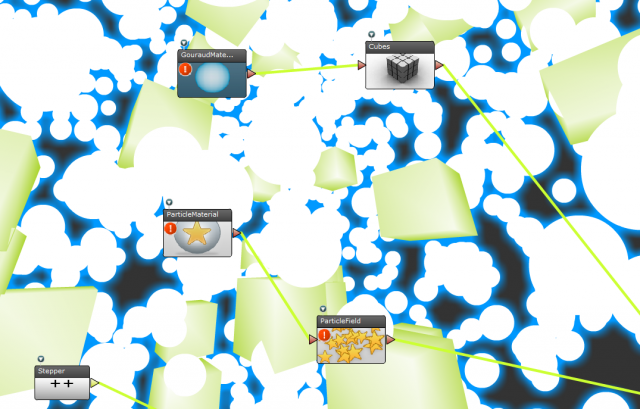Author Archive
-
Chameleons, Cupcakes & Sharks – Oh my!
29th May 20099After the frenetic workload that went into my last game Kyobi, I needed a break from development. Add to this an insane pile of “real life” coding work and I was finding it really hard to motivate myself to get on with something new. Working until 3am in the morning day after day does that to me.
So my own personal game projects bit the dust. I tried mocking-up an overhead tank shooter, but that didn’t get so far because I didn’t have a firm vision of where the game should go. I even tried doing a co-op breakout style game and failed to even finish this yet. But I’m not posting here to bitch about my lack of motivation. I’m posting to say what I’m doing about it 🙂
The answer can be summed-up in the picture below:
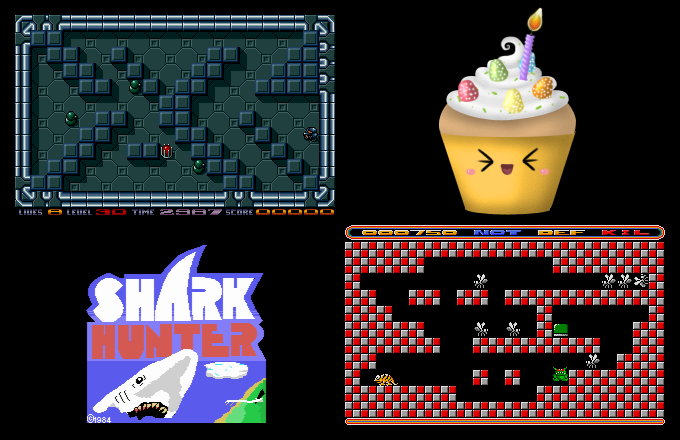
Here are four very different games. Top left is Robotz – a tactical / puzzle style shooter based on an Atari ST classic. Destroy the generators, this lets you destroy the robots (which are constantly chasing shooting at you). Destroy all the robots and the exit appears. It’s very simple, but actually really fun. The graphics are currently being pixelled for this, and I should have some level mock-ups to show next week. I’ve already done the level designer, mapped out 30 levels and have the soldier running around happily shooting at generators.
Bottom left is Shark Hunter. This was an awesome 8-bit MSX game. You had to mend your fishing nets, while fighting off the sharks and try to survive a whole year. Another nice simple game mechanic, but it has stood the test of time well, and I feel it’ll convert into Flash with ease. And hey, who doesn’t like spearing sharks? Concept graphics work for this is under-way, although no code has been written yet.
Top right is a cup cake. I have a really nice and innovative idea for a time-management game, that I have not seen done before. So I can’t give out too many details at this stage. But I think it could be a real success. I’ve got some awesome graphics through, and I’m actually toying with the idea of doing several games using the same assets – the time management one being the core, and then some simple spin-offs like a “spot the difference” style game, or a “cup cake dress-up”. Hey, you never know 🙂
Finally bottom right is a wonderful game that I loved on the ST. It was called Color Clash and was a PD game by Animal Soft. I doubt I’ll keep the same name as I don’t feel it does the game justice. You play the role of a chameleon who (as you’d expect) can change colour. Different colours have different actions. The yellow one can jump. The green one has a tail that he can flick to smash blocks / baddies. The red one inflates and floats and the blue one has a tongue that shoots out and can slide blocks around. I’m taking this core mechanic which works so well and tarting it up big-time.
40 levels have been designed already, and I’ve got the chameleon charging around the levels happily. Jumping, falling, sliding. Still need to do the baddie logic and colour changes. I want to do the original justice, but it also needs bringing up to date, so I’ll be refining and tweaking as I go. Still trying to track down the original author for his blessing on this project. Wish me luck.
I am working on Color Clash and Robotz at the same time. I quite like having the two projects to swap between. The other night I was stuck in getting my chameleon to jump-slide properly, and rather than admit defeat (for the night) and fire-up Left 4 Dead, I hit Robotz instead and got the shooting rebounds working smoothly. I’m also finding as they’re both similar 2D styled games, that I can share quite a bit of the code between them. Always a bonus.
So which will come out of the gates first? Honestly not sure. Right now Color Clash is the most complete, but has a lot of graphics work to be done to it. So Robotz may head it off at the final strait. Time will tell …
-
Announcing Turbo Stripe Software
25th May 2009I was digging through some boxes in our attic when I came across an old folder. It contained computer magazines and comics I had made back in the mid 1980s, aged around 10 years old. I used to sit there and literally draw my own magazines. I’d draw the covers, the layout, even screen shots for the games I was reviewing. One such magazine I called Arcade & Software. Very much inspired by Computer + Video Games (C+VG) of the mid 80s:

Here is the cover of issue 1. I only ever made 2 issues. The two games I’ve drawn on the cover are Knight Tyme (on the left) and Alien 8 on the right. Not that the robot looks a thing like the robot in Alien 8 mind you.
While flicking through Arcade & Software what caught my eye however was the inclusion of the Turbo Stripe Sofware Catalogue. This catalogue contained a list of games that as a 10 year old I really wanted to be making myself, complete with box cover artwork, short descriptions and even prices and ordering instructions.
These games never existed, I didn’t actually code them back then. I simply wasn’t capable of doing so at that age. It would be a couple more years before I started programming for myself. Reading through this fictitious catalogue there was something captivating about knowing that several decades ago this is what I really wanted to be doing. And these were the sorts of games a 10 year old me wanted to making.
So you know what? It’s time to fulfil a small part of that childhood dream and actually make one of those games. But which one? To decide let’s push embarrassment aside for a moment and dive right in …
… I present to you, in all its time-warped yellow-sellotaped glory the Turbo Stripe Software Catalogue (1987). Please excuse the horrendous spelling. And I claim no responsibility for copyright infringement re: the game ideas shown.
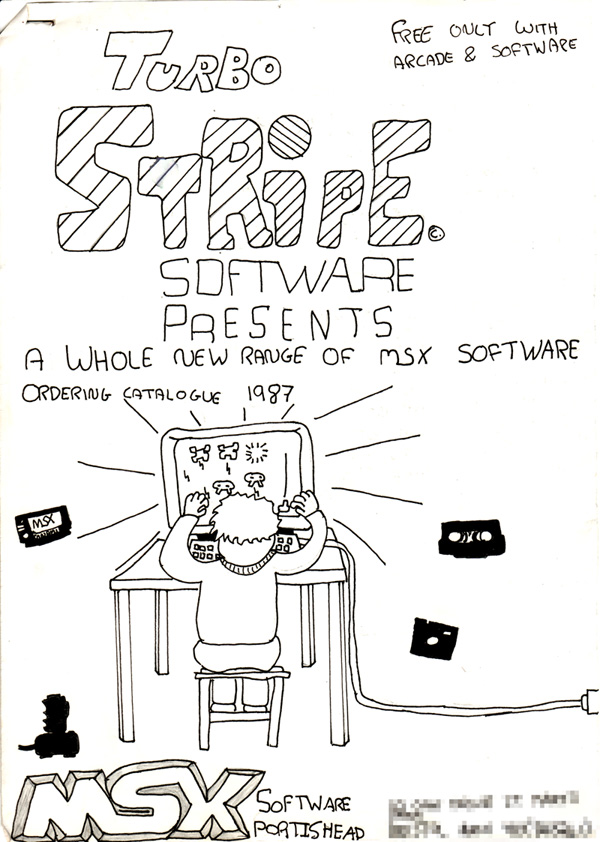
So here’s the front cover. The first thing to explain is that as a child I owned a Toshiba MSX 8-bit computer. In hindsight this was an incredible machine. It had a built-in cartridge port for which you could get some amazing games from the likes of Capcom and Konami. Games such as Nemesis (Gradius), Road Fighter, Sky Jaguar and Castlevania. It also had a tape recorder for the cheap tape-based games from Mastertronic, Ocean, Gremlin and other software houses of the day.
It was a great computer, even if virtually no-one else owned one (which made acquiring games in the school playgroup extremely difficult).
Obviously the kid playing on the MSX on this front cover is doing so with some kind of advanced invisible Wiimote. Turning the page …
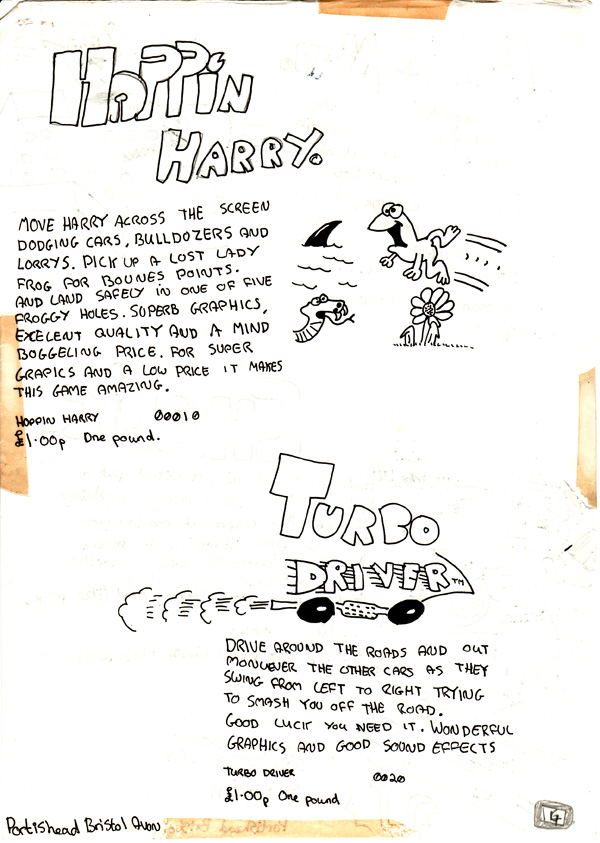
And here we have the first two games. I’ll give you no clues as to what Hoppin Harry was going to be a clone of. As you can see collecting the “lady frog” would net you “bounes points” [sic]. I think the 00010 number is the ordering code. Obviously leaving room for another 99,000 or so titles of similar quality.
Turbo Driver was my version of the bastard child of Spy Hunter and Super Sprint. Needless to say this would have incredible graphics too (at least I managed to spell that correctly this time). I’m not entirely sure how this game would play or look, I think it’s just filling space to be honest 🙂
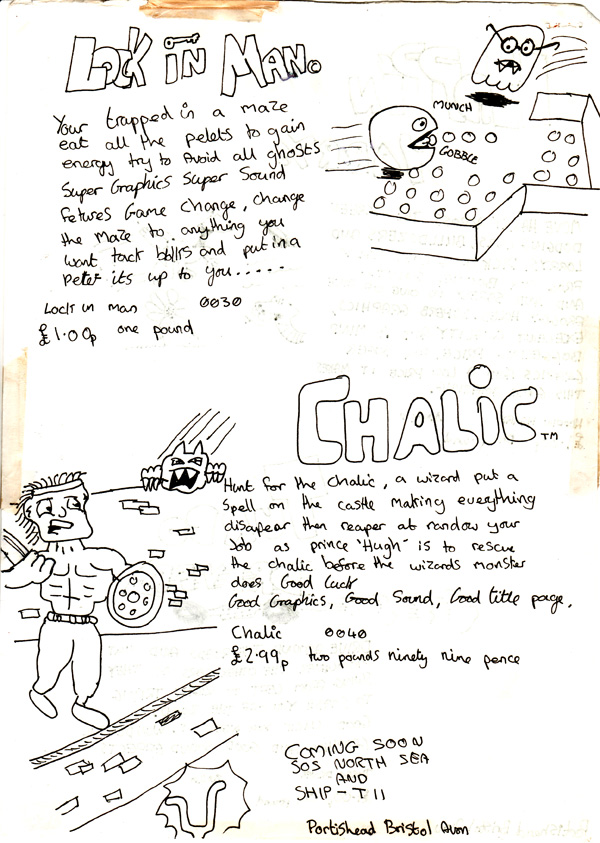
Ahh the classic Lock In Man. No, it has nothing to do with after-hours at a pub/bar. Instead you are trapped in a maze with “pellets” to eat and ghosts to avoid. I’m not sure why I didn’t just call it Pacman and be done with it. The one thing I remember most about my plans for this game, and which is alluded to in the description, is that it would ship with a level editor. I always got bored of the single level layout of Pacman and figured it’d be fun to create your own. I still think there is a shred of inspiration in that idea. Perhaps the maze could literally change around you as you play? So it becomes not so much about reflex based survival as it does puzzle solving.
The final game in the catalogue is Chalic. That’s my 10 year olds spelling of chalice (i.e. a cup/goblet). This was going to be a hybrid Gauntlet / Rogue game with more fantasy RPG overtones. As you can read in the description you’d be trapped in an ever-changing maze, and are trying to rescue a chalice before the Wizards monster does. I’ve no idea on earth why a chalice would need “rescuing”. I mean it’s just a bloody cup. But obviously it was in danger. Maybe if the Wizard drank from it, the world would be forever enslaved and “Prince Hugh” would wither and die? Who knows. I wrote the damned thing and even my mind is still reeling.
It’s worth noting that “Chalic” was only going to have “good” graphics rather than “excellent”. I find it interesting that I wrote it would have a “good title page”. Obviously game title pages were very important to me at the time. And the more I reflect on that I realise that actually they still are important to me today. I will often spend a disproportionate amount of time on the title pages for my games.
Coming soon was SOS North Sea and Ship-T11. SOS North Sea was a blatant rip of Chop Lifter. Ship-T11 was just going to be a shmup, the T11 part being the name of my calculate I had at the time. I’m not including these two games as being eligible for creation.
Which of these four gems do I feel is worth of being converted to Flash? It’s a tough choice.. personally I’m favouring “Chalic”, but I’ll open this up to the couple of you insane enough to have read this far. Which would you like to play? 🙂
-
The further adventures of Kyobi + Updated sales figures
9th May 2009This is the story of the little game that just keeps on traveling. Since writing about my experience selling Kyobi a couple of weeks ago I just wanted to update you on what had happened since…
Part 1 – Kyobi won 3rd place in the Whirled Single-Player Game Competition
This was both unexpected and great news! I’ve blogged about Whirled before, the anarchic but beautifully freeform Flash virtual world. They run a quarterly developers competition where games are split into two categorys: multi-player and singer-player. Obviously Kyboi is about as far from a multi-player game as you can get, so that category was out of bounds for me (which is a shame as it has significantly bigger prizes!). But I spent some time making Kyobi Whirled compatible, uploaded it and hoped for the best.
And it paid off 🙂 (thanks Chris/Adam!!) It paid off to the tune of $1000 in fact. You can see all the winning games here.
What I find interesting about Whirled is that my game is for sale in the shop there. I get in-world credits from these sales, but I also get my share from the developers bling pool too. The terminology might be a bit “what the hell?” but once you get over the pimp-my-ride lingo it starts to make sense. In short: for as long as your game is on Whirled, and brings people to Whirled, you get a cut of that. This translates into real money. If your game brings people to Whirled and they sign-up, you get 30% of whatever they spend for life. That could add-up significantly, so don’t ignore this fact.
You can also sell “furniture”, “backdrops”, “toys” and “avatars” in the Whirled shop. So I pulled apart the graphics from Kyobi, put them into the shop and now they are on sale. Every day people are buying these items. I took the background from my game, changed it a little and now it’s a room background to buy. And people do buy it!
Here is a picture of my room, decked out with most of the Kyobi game items available on sale:
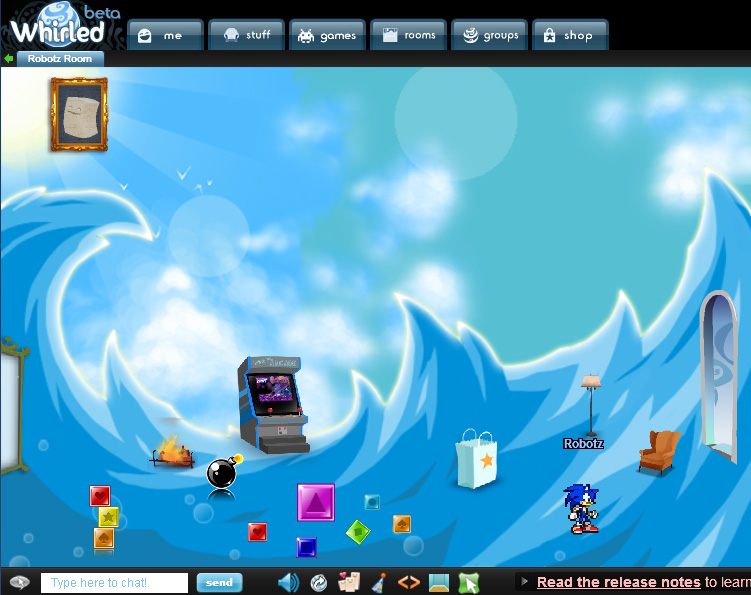
I believe this is an easy avenue for income, both real and virtual. Given that you made the assets for your game already, it’s a no-brainer and I’ll certainly be doing it again.
Part 2 – Do people REALLY click those sponsor logos?
This question gets asked a lot, most recently here on the FlashGameLicense forums. Honestly, I was quite skeptical about it at first. When Kongregate made me a Primary offer for sponsoring Kyobi, the money was paid as an advance on the income these referral links would make.
To be brutally honest I took the offer and ran, never expecting to hear anything again. I’m glad to say I completely misjudged this part of the deal and my first months payment was just shy of $800. I will get paid another 2 months worth of referrals before the deal ends. While $800 doesn’t sound like a huge sum of money (and on its own it isn’t) you have to remember Kongregate sponsored the GameJacket version of Kyobi – so not only do I get money from someone clicking “More games” for example, but also from the pre-roll ad at the start. Combine these together and with a really popular game that travels well it can add-up significantly. I consider the total plays Kyobi is getting across all versions to be really good, but there are lots of games that do significantly larger numbers of plays – and if they are being paid per click there is some very serious income potential here too.
My advice? Don’t under-estimate these kinds of offers from sponsors. And never under-estimate just how valuable those “more games” links are to your sponsor. People really do click them, in their thousands. So sell your game for a decent price accordingly!
Part 3 – Skill Gaming – A great new revenue stream for Flash Developers?
On the most basic level Skill Gaming sites are sites that offer payments based on how well you play the game. It’s a form of gambling really, with payouts being based on who else is playing the game, how well they are doing, etc. King.com is an example of a site that makes a seriously large amount of money from this market. But there are many others, and I believe this is a growing sector in more ways that one.
At the moment King are sponsoring games left right and center, because they drive large numbers of people to their site – lots of whom then go on to spend real money. Most (if not all?) of the King sponsorship deals are just standard Primary ones though, they pay for branding and your game is a magnet for players to their site.
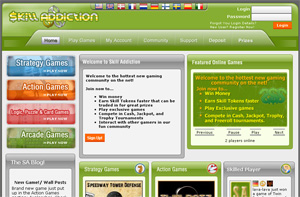 However this is changing – new sites such as SkillAddiction.com are starting that take your game, convert it to be more “skill game” focused and then you can get a percentage of revenue it generates on that site.
However this is changing – new sites such as SkillAddiction.com are starting that take your game, convert it to be more “skill game” focused and then you can get a percentage of revenue it generates on that site.I have been contacted by two different companies, both of whom want versions of Kyobi for their sites on this basis.
There are some factors to consider when it comes to skill gaming – first of all it doesn’t suit all types of game. They have to be quite specific in nature, often they have to be completed within 4-5 minutes, and you have to be able to know the sorts of scores that are possible. For example I’ve had to change Kyobi to make it a lot harder at the start, and to make the play just get progressivly faster until it finally beats you – the current game doesn’t work like this, I inject “breather” levels into the game ever few rounds to give the player a break. But obviously you can’t do this when they are trying to win money.
Lots of current skill gaming sites buy-up Flash games just to pad out their sites and draw people in, then they hope those visitors will explore the “other” side of their site. But as I said this is changing, new skill gaming sites are appearing that will use your game directly with the players, offering pay-outs when playing it. And if they offer you a percentage of this then there is massive potential here. Contact the guys at SkilAddiction.com to see if your game would suit their site, it could benefit you.
I’ll report back to let you know how Kyobi fares in this market soon. I still need to finish my SkillAddiction version of it for release (an insane workload during crunch time for an MMO delivery has prevented this so far sadly)
Part 4 – Oberon Media version finally passes QA!

After what seems like an eternity Kyobi finally passed Oberon Media’s QA process. Their API is pretty complex to work with, and you have to build your game running under a JavaScript test harness that simulates calls and events to/from your game. Certainly quite far removed from the simplicity of most sponsors APIs. It’s not massively challenging, but definitely more time consuming.
They also required a huge load of paperwork to be signed, and contrary to all the other big sponsors (Shockwave, BigFishGames, etc) you have to actually print and post the paperwork to them. Sending via UPS cost me nearly $80. Why they don’t accept it via email like the rest I don’t know. On the plus side once you have sent them one contract you don’t need to post them another in future, should they buy a new game from you.
Their payment terms are also extremely poor compared to every other sponsor out there. You are looking at a wait of around 60 days from the date the game goes live across their network. 60 days is an incredibly long time even for standard companies, let alone an indie developer. On the upside of course I don’t rely on this money for anything essential like the mortgage or feeding my family. But if you do then bear this in mind if ever dealing with them. It’s not a deal breaker at all, I’m just saying be aware of it. I also don’t believe the payment should be from the date they release the game. It should be from the date they approve the QA of it, but that’s another story.
So why go through all this hassle? because it will place the game across a number of sites with extremely significant visitor figures. They run MySpace games for example. I’d wager that the volume of plays my game gets when it hits the sites they licensed it for will be significant. I’ll report back later in the year to see if my thoughts confirm this.
Sadly Oberon don’t offer advertising royalty payments on Flash games (they do for ActiveX/C/Shockwave games). Originally when I first started talking to them it looked like this could be a deal, but things changed internally and it fell away. Had they been able to offer me an ad cut then I actually would have sold the game exclusively to them.
Part 5 – Shockwave.com version finished. Now devoid of Nazi imagery!
It surprises me that sponsors are still licensing Kyobi. I don’t know why it surprises me, I mean it’s still a fun little game – I guess it’s just the “Flash mindset” where you assume your game is only popular and of interest to sponsors for a month or so, and then is swallowed up in the ever changing tide of new releases. I’m quickly realising this assumption is wrong, and there is actually a bit of a long-tail for game sales, just as in every other medium.
The most recent sales was to Shockwave.com, who contacted me via FlashGameLicense (that site is worth every single 10% they ask for!). Their offer was a good one, and the requests were simple. Logo here, few button changes there, basic API for highscores.
Then they asked if I could change the title page. Apparently the girl didn’t sit well with their demographic. When I commision work from artists I always insist that they create it over as many layers as is possible within Photoshop, so it’s easily changed. This meant I was able to open the title page, hide the girl layer, shunt the logo around and create a new more “subtle” version. All-in about 10 minutes work. I was happy, they were happy. Job done. Or maybe not …
 Then the “Nazi” issue hit. Yes, you read that correctly. If you’ve played Kyobi you’ll know it involves throwing coloured blocks around. Apparently there was an issue with my pink block. The problem was that it featured a triangle. A pink triangle.
Then the “Nazi” issue hit. Yes, you read that correctly. If you’ve played Kyobi you’ll know it involves throwing coloured blocks around. Apparently there was an issue with my pink block. The problem was that it featured a triangle. A pink triangle.Highly confused by this being an issue they explained that a pink triangle was what Nazi’s used to brand homosexuals with while in concentration camps. I had always assumed the pink triangle was the gay pride symbol. A little Wikipedia reading later and it confirms both are true. It’s origins are one of the horrific brands used by the Nazi’s, but these days it is more commonly associated with the paramount opposite of this.
Also the actual symbol is an inversed triangle. The triangle in my game is the other way up.
Anyway, not wanting to be seen to promote Nazi’s in any way at all (even if it feels more like it would be promoting gay pride if anything) I agreed and modified the block, turning it a brown colour instead.
So there you have it – the Shockwave version should be released on May 12th and will be 100% cute girl and Nazi-branding free! If you’re going to sell a game to Shockwave be prepared for artistic change requests, and whatever you do avoid any of these shape/colour combinations!
Part 6 – (the penultimate part, honest) – iPhone game sales update
I reported last time that the iPhone version of Kyobi was enjoying success thanks to a promotion on the hit game iDare. I wondered if this might just be a flash in the pan, or if the sales rate would be sustained. Thankfully it’s still going strong and shifting 3 digits worth of copies per day. The amount varies a lot, but averages at around 250 sales a day, with the usual peaks and troughs you’d expect. I don’t know for how much longer this will last of course, but it does mean I’ll see at least one months worth of decent royalty payments from it. And of course it won’t ever stop selling, it’ll just reduce back to a much lower rate – but even this will ensure a nice small payment coming in each month.
Part 7 – Summary
Wow, I had no idea this would turn out to be such a long piece when I started. I could probably have broken it into 6 different blog posts. But if you got this far (and actually read up to here rather than scrolled) then thanks and I hope you found it interesting and some of it useful.
Factoring in new sponsored versions of Kyobi, the unexpected Kongregate payment, the Whirled prize money and money I know I’ll receive from iPhone sales so far, I can report that this one little game has now netted me $10,105. I know there will be more iPhone and Kongregate payments to come over the next two months (although I expect them to be lower). And maybe another portal may even buy it, who knows? 🙂
I’ve learnt an awful lot from this one game. Things I will take into my next game for certain. The Whirled link-ups, the possibility of skill gaming revenue share, not to under-estimate referal payment offers and the long-tail of sales.
-
Our new showreel
30th Apr 2009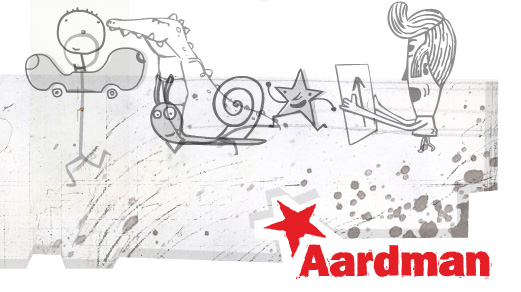
After months of hard work the Aardman Online team, of which I’m a part of , released the new version of the company web site: www.aardman.com. Wednesday was a hectic day for us all as we put the site live. Doing last minute changes you never expected to be doing 😉The design I feel is a brave one. Created by Luis Cook it’s a clean fresh sheet of paper, where all the superflous items are resigned to shades of grey. And the colour of the beautiful imagery and showreels is allowed to stand out and be the centre of attention. Which on a site like ours is exactly how it should be.
Please have a play with the home page (hint: click the animated characters as they charge across the top of the site). But the main reason for this post is to shout that our new Online showreel, featuring loads of our Flash games, is now up:
http://www.aardman.com/online/
Enjoy 🙂
-
SourceBinder – pure AS3 awesomeness!
23rd Apr 2009Quite out of the blue I received an invite to the SourceBinder project tonight. I honestly couldn’t even remember what it was, but after a couple of minutes playing I was hooked!
If you are experienced with node based creation tools, like FilterForge for example, then you’ll have a good idea what this is about. Basically it’s an FP10 visual creation tool – you can create your own nodes (or use many of the public ones up there) and chain them together to create stunning visual effects. Loads of libraries are built in already like JigFlashLib, Tweener, Flint and PV3d, so nodes can be created using these.
Nodes can perform tasks such as colour changing, mouse input, sound handling, PV3D creation and loads more. They are simple AS3 classes (which you can edit live online). You chain them together using a neat drag and drop interface, the final “display renderer” node being responsible for the output.
It’s just great – I urge you to try it!
Hire Us
All about Photon Storm and our
HTML5 game development services
Recent Posts
OurGames
Filter our Content
- ActionScript3
- Art
- Cool Links
- Demoscene
- Flash Game Dev Tips
- Game Development
- Gaming
- Geek Shopping
- HTML5
- In the Media
- Phaser
- Phaser 3
- Projects
Brain Food


